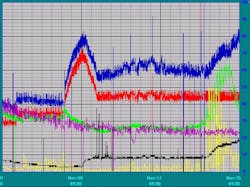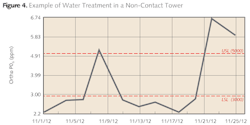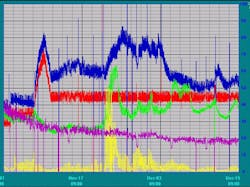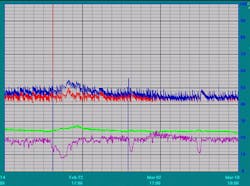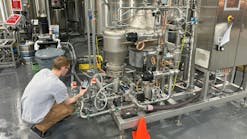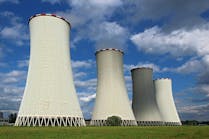by Rick Lyon
The website home page for Nucor-Crawfordsville reads, "In an old cornfield in Crawfordsville, Indiana, in America's rust belt, a maverick company called Nucor is attempting nothing less than the resurrection of the American dream." Perhaps it would be more accurate to say that in 1988 with the completion of the world's first thin-slab casting mini-mill, Nucor accomplished nothing less than the resurrection of the American steel industry.
With a production capacity of more than 26 million tons per year, Nucor is not only the largest producer of steel in the United States but perhaps more importantly the largest metals recycler in the Western Hemisphere. The Crawfordsville mill is the world's first thin slab caster facility and what is today commonly referred to as a mini-mill.
The mill started construction in 1988 with one caster, a four-stand hot mill and a cold mill. Today, the facility has grown to include two thin slab casters, a six-stand hot mill, a cold rolling mill, a galvanizing line, and the new state-of-the-art Castrip mill. The product line at the Crawfordsville mill includes a diverse selection of sheet steel products sold in coils as hot rolled, cold rolled, galvanized, and Castrip (ultra-thin cast sheet steel).
This diversity of product and experimental birth of this mill in 1988 required similar diversity and an experimental nature for many of the support systems -- including the water treatment facilities. The Crawfordsville mill has five contact cooling systems, six non-contact cooling systems and four closed loop systems. Its water treatment program supplier is Nalco.
Nalco first introduced its cooling water automation system, 3D TRASAR technology, to the new Castrip facility. The system offered improved chemical inhibitor control and a reduction of scale and corrosion problems, a significant improvement over previous methods which included lab testing and manual operator adjustments to control the inhibitor dosage.
In 2012, Nucor management challenged the water treatment department and Nalco to take the department to the "next level" of cost reduction and water quality. The water treatment department managers and operators realized that this had to include an upgrade of the automation and technology tools to achieve better control and improved water quality at lower cost.
Nucor decided to install Nalco technology in the hot mill non-contact cooling system. Both Nucor and Nalco saw the opportunity to integrate 3D TRASAR technology with the existing PLC controlling the cooling water systems and operations management software.
Scale, corrosion, fouling, and biological growth all are threats to cooling water systems and production equipment. All of these impact water usage and water quality, which in turn can impact production, maintenance and water treatment costs. 3D TRASAR technology uses real-time monitoring, patented control technology, proprietary stress resistant chemistry, and 24/7 information management capabilities to deliver improved scale, corrosion and microbiological performance in cooling systems.
The system detects when upsets occur that may cause scaling, corrosion and bio-fouling. It then automatically makes chemical feed adjustments to the treatment program and notifies support staff when attention is required. The result is a balanced and efficient cooling system that requires less maintenance, insures no over- or under-dosing of chemicals, helps lower operating costs, and provides maximum protection of production and water system equipment.
In September 2012, installation of the 3D TRASAR unit for the hot mill non-contact cooling water system was completed. The unit provides eight 4-20 mA outputs and two alarm relays to the PLC. The operations monitoring software reads these inputs and provides real-time trending that is not available with either system alone. The unit is also able to send alarms to Nalco and Nucor via cell phone or email. When the unit detects that a parameter is outside defined control ranges, it communicates immediately and directly to the Nalco representative and Nucor operators.
The eight parameters monitored by the system and sent to the PLC include:
- Inactive Polymer "I" -- indicates the total chemical present in the system
- Active Polymer "A" -- indicates the active chemical residual in the cooling system
- ORP -- measures "oxidation reduction potential" of the cooling water which directly correlates to the presence and effectiveness of the biocide treatment program
- Copper Corrosion -- measures the potential for corrosion of yellow metals in the cooling systems
- Mild Steel Corrosion -- measures the potential for corrosion of mild steel such as piping and production equipment
- Fouling -- measures the cleanliness of the fluorometer
- pH -- indicates the potential for scaling or corrosion
- Conductivity -- indicates the potential for scaling
Figure 1 is a screenshot of a trend showing the first 24 days after the system was installed. During this initial timeframe, the new system was not controlling the chemical feed. This period was used to compare the previous method of controlling inhibitor levels using lab testing and manual pump adjustments to the period after the unit takes control of the chemical feed.
Several things quickly became apparent about the cooling system dynamics that were not noticeable prior to implementing this technology. In Figure 1, the spikes in the copper corrosion (yellow) and ORP (green) occurred each time bleach was automatically fed to the system. Additionally, the rapid peaks and valleys in the "A" and "I" correspond to each time the cooling tower make up valve refills the tower.
Compare the information in Figure 1 collected by the 3D TRASAR controller using manual operator control of the inhibitor to the lab test data in Figure 2 entered into the Nalco Vantage database.
The new unit began controlling the chemical inhibitor feed on Oct. 19, 2012. Figure 3 shows that residuals began to level out as control was improving. Soon after installation, the unit quickly proved its value.
After a few days of controlling the chemical feeds, the Nalco system got its first real test at spotting and compensating for an event that caused a disruption in water quality. This was noticed when the "I" suddenly increased, while the "A" stayed constant. The system automatically adjusted chemical dosage to maintain the active "A" polymer within the designated control range to protect critical mechanical components of the system. Further investigation discovered a mechanical problem causing the upset condition. The unit notified Nalco representatives and Nucor operators of this situation, and they were able to alert the maintenance department and facilitate the repair.
Compare the control by the Nalco unit as it compensates for the system upset to the Nucor lab test results in Figure 4: While lab tests showed a similar rise near the end of the plot, it is not as clear that an upset condition exists as shown in Figure 3.
The mechanical problem was quickly repaired by the maintenance department, but it took longer to correct the system upset. Eventually the non-contact cooling water returned to normal chemistry; the collected information reflects that in Figure 5.
Before implementing 3D TRASAR technology, Nucor-Crawfordsville staff controlled their chemical program adequately, obtaining acceptable scale and corrosion results. The previous control method consisted of frequent testing of the active chemicals and then adjusting the chemical feed pump manually.
Today, they are achieving much better control of the active residuals. Perhaps more importantly, this technology demonstrates the ability to react immediately to stress or upsets in the system, automatically adjusting the chemical feed as needed before the operator is even aware of a developing problem.
By connecting the 3D TRASAR unit to the cooling tower PLC and the operations monitoring software, the operator can immediately see and react to upset conditions before they can be harmful to the system and production equipment.
By continuously monitoring the difference between the Inactive Polymer "I" and the Active Polymer "A", water treatment operators can instantly respond to contaminants, temperature and other factors causing stress on the cooling system.
Now compare the results of the cooling system with good control (Figure 6) and no unusual stress on the system to the lab test results (Figure 7).
The water treatment operators continue to monitor residuals with lab testing in parallel with the automation. They have not had to make manual adjustments to the chemical feed pump since handing over control to the Nalco technology.
Cost analysis and trending of chemical usage comparing inhibitor control with 3D TRASAR technology versus manual control shows approximately a 30 percent reduction in chemical usage.
About the Author: Rick Lyon is a Water Treatment Operator at Nucor Steel – Crawfordsville. He has 40 years of industrial water and wastewater treatment experience and is certified for Class D Industrial Wastewater, Class WT-3 Drinking Water, and DSL Distribution Systems.


